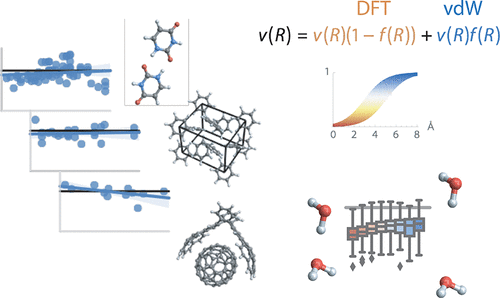当前位置:
X-MOL 学术
›
J. Chem. Theory Comput.
›
论文详情
Our official English website, www.x-mol.net, welcomes your
feedback! (Note: you will need to create a separate account there.)
Electronic Exchange and Correlation in van der Waals Systems: Balancing Semilocal and Nonlocal Energy Contributions
Journal of Chemical Theory and Computation ( IF 5.7 ) Pub Date : 2018-02-15 00:00:00 , DOI: 10.1021/acs.jctc.7b01172 Jan Hermann 1, 2 , Alexandre Tkatchenko 2
Journal of Chemical Theory and Computation ( IF 5.7 ) Pub Date : 2018-02-15 00:00:00 , DOI: 10.1021/acs.jctc.7b01172 Jan Hermann 1, 2 , Alexandre Tkatchenko 2
Affiliation

|
Short-range correlations in motion of electrons in matter are captured well by semilocal exchange–correlation (XC) functionals in density functional theory (DFT), but long-range correlations are neglected in such models and must be treated by van der Waals (vdW) dispersion methods. Whereas the effective range of distances at which fluctuations are correlated is usually explicit in the vdW models, the complementary range of semilocal functionals can be observed only implicitly, requiring an introduction of empirical damping functions to couple the semilocal and nonlocal contributions to the XC energy. We present a comprehensive study of the interplay between these short-range and long-range energy contributions in eight semilocal functionals (LDA, PBE, TPSS, SCAN, PBE0, B3LYP, SCAN0, M06-L) and three vdW models (MBD, D3, VV10) on noncovalently bonded organic dimers (S66×8), molecular crystals (X23), and supramolecular complexes (S12L), as well as on a series of graphene-flake dimers, covering a range of intermolecular distances and binding energies (0.5–130 kcal/mol). The binding-energy profiles of many of the DFT+vdW combinations differ both quantitatively and qualitatively, and some of the qualitative differences are independent of the choice of the vdW model, establishing them as intrinsic properties of the respective semilocal functionals. We find that while the SCAN+vdW method yields a narrow range of binding-energy errors, the effective range of SCAN depends on system size, and we link this behavior to the specific dependence of SCAN on the electron localization function α around α = 1. Our study provides a systematic procedure to evaluate the consistency of semilocal XC functionals when paired with nonlocal vdW models and leads us to conclude that nonempirical generalized-gradient and hybrid functionals are currently among the most balanced semilocal choices for vdW systems.
中文翻译:

范德华系统中的电子交换和相关:平衡半本地和非本地能源贡献
密度泛函理论(DFT)中的半局部交换-相关(XC)泛函很好地捕获了电子在物质中运动的短程相关性,但是在此类模型中忽略了长程相关性,必须通过范德华(vdW)进行处理。 )分散方法。尽管在vdW模型中通常会明确确定与波动相关的距离的有效范围,但是只能隐式地观察到半局部函数的互补范围,这需要引入经验阻尼函数以将半局部和非局部贡献耦合到XC能量上。我们目前对八个半局部功能(LDA,PBE,TPSS,SCAN,PBE0,B3LYP,SCAN0,M06-L)和三个vdW模型(MBD,D3)之间的近距离和远距离能量贡献之间的相互作用进行全面研究,VV10)在非共价键合的有机二聚体(S66×8),分子晶体(X23)和超分子复合物(S12L)以及一系列石墨烯-片状二聚体上,涵盖了一系列的分子间距离和结合能(0.5– 130 kcal / mol)。许多DFT + vdW组合的结合能谱在数量和质量上都不同,并且某些定性差异与vdW模型的选择无关,从而将它们确立为各个半局部功能的内在特性。我们发现,尽管SCAN + vdW方法产生的束缚能误差范围很窄,但SCAN的有效范围取决于系统大小,并且我们将此行为与SCAN对电子定位函数α的特定依赖性(α= 1左右)联系起来。 。
更新日期:2018-02-15
中文翻译:

范德华系统中的电子交换和相关:平衡半本地和非本地能源贡献
密度泛函理论(DFT)中的半局部交换-相关(XC)泛函很好地捕获了电子在物质中运动的短程相关性,但是在此类模型中忽略了长程相关性,必须通过范德华(vdW)进行处理。 )分散方法。尽管在vdW模型中通常会明确确定与波动相关的距离的有效范围,但是只能隐式地观察到半局部函数的互补范围,这需要引入经验阻尼函数以将半局部和非局部贡献耦合到XC能量上。我们目前对八个半局部功能(LDA,PBE,TPSS,SCAN,PBE0,B3LYP,SCAN0,M06-L)和三个vdW模型(MBD,D3)之间的近距离和远距离能量贡献之间的相互作用进行全面研究,VV10)在非共价键合的有机二聚体(S66×8),分子晶体(X23)和超分子复合物(S12L)以及一系列石墨烯-片状二聚体上,涵盖了一系列的分子间距离和结合能(0.5– 130 kcal / mol)。许多DFT + vdW组合的结合能谱在数量和质量上都不同,并且某些定性差异与vdW模型的选择无关,从而将它们确立为各个半局部功能的内在特性。我们发现,尽管SCAN + vdW方法产生的束缚能误差范围很窄,但SCAN的有效范围取决于系统大小,并且我们将此行为与SCAN对电子定位函数α的特定依赖性(α= 1左右)联系起来。 。











































 京公网安备 11010802027423号
京公网安备 11010802027423号